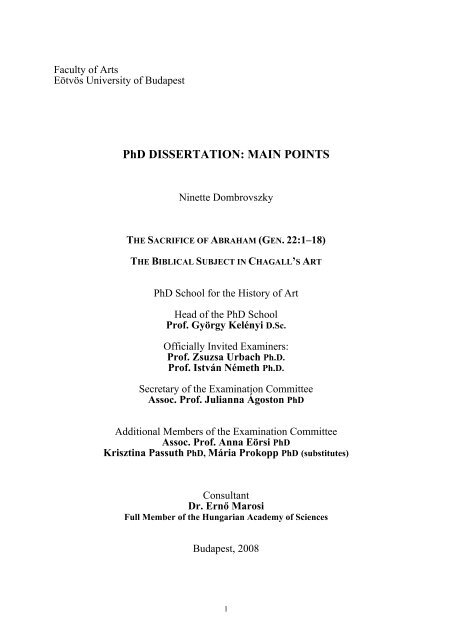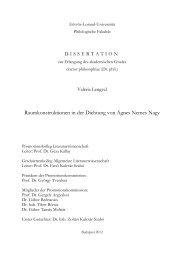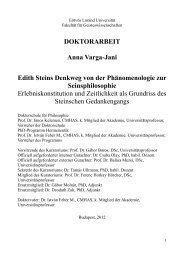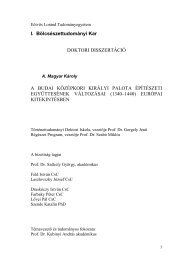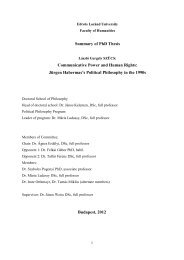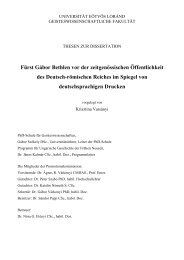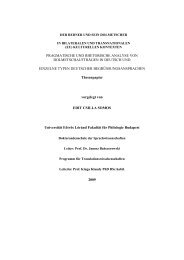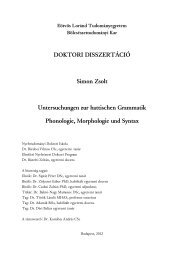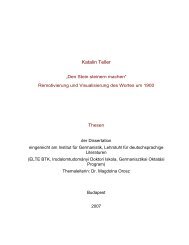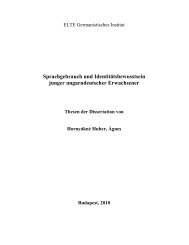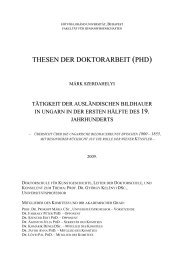PhD DISSERTATION: MAIN POINTS - ELTE BTK disszertációk
PhD DISSERTATION: MAIN POINTS - ELTE BTK disszertációk
PhD DISSERTATION: MAIN POINTS - ELTE BTK disszertációk
You also want an ePaper? Increase the reach of your titles
YUMPU automatically turns print PDFs into web optimized ePapers that Google loves.
Faculty of Arts<br />
Eötvös University of Budapest<br />
<strong>PhD</strong> <strong>DISSERTATION</strong>: <strong>MAIN</strong> <strong>POINTS</strong><br />
Ninette Dombrovszky<br />
THE SACRIFICE OF ABRAHAM (GEN. 22:1–18)<br />
THE BIBLICAL SUBJECT IN CHAGALL’S ART<br />
<strong>PhD</strong> School for the History of Art<br />
Head of the <strong>PhD</strong> School<br />
Prof. György Kelényi D.Sc.<br />
Officially Invited Examiners:<br />
Prof. Zsuzsa Urbach Ph.D.<br />
Prof. István Németh Ph.D.<br />
Secretary of the Examination Committee<br />
Assoc. Prof. Julianna Ágoston <strong>PhD</strong><br />
Additional Members of the Examination Committee<br />
Assoc. Prof. Anna Eörsi <strong>PhD</strong><br />
Krisztina Passuth <strong>PhD</strong>, Mária Prokopp <strong>PhD</strong> (substitutes)<br />
Consultant<br />
Dr. Ernő Marosi<br />
Full Member of the Hungarian Academy of Sciences<br />
Budapest, 2008<br />
1
1. ● The aim of my research is to present the biblical works of Marc Chagall, and within<br />
this framework his rendition of Abraham’s sacrifice. Chagall, one of the most influential<br />
artistic personalities of the 20 th century, explained and reformulated biblical stories, among<br />
other things. The subject of my thesis is Abraham’s sacrifice (Gen 22:1–18) within Chagall’s art and<br />
the unique style applied by him; I make a review of the subject, present the extant artistic illustrations,<br />
and subject them to iconographic examination. The works of Chagall that have a biblical subject,<br />
the unique interpretation they gave, and their specific imaginative world represent a new chapter in the<br />
biblical illustration of the 20 th century. This is the reason why I was very much taken with the oeuvre<br />
of the artist, and in this framework with the Sacrifice of Isaac. In my thesis I examine the problem as<br />
regards the history of art, namely the extent to which this classic theme could prevail in the modern<br />
avant-garde world so characteristic of the early 20 th century, and the extent to which it deviated from it<br />
in the case of Chagall.<br />
2. ● A separate section deals with the Old Testament interdiction on graven images and<br />
notes that its interpretation has changed over the centuries. In this respect, when surveying the<br />
oeuvre of Chagall, I try to discover how much his work remained in line with traditions and<br />
how much it strayed from them. The case of Chagall has to be linked to the notion of<br />
interdiction on graven images, as it is related to the violation of it (at least according to the<br />
traditional Jewish interpretation).<br />
At the same time, as a modern artist of the 20 th century and as a freethinker ahead of<br />
his time, Chagall was able, by means of his particular reinterpretation of the Bible and his<br />
pictorial representation of it, to anticipate the Jewish-Christian Europe concept of the present<br />
day. Chagall created harmony between contradictions that seemed to be almost irreconcilable.<br />
He was able to bridge the chasms that had grown ever wider over the centuries between<br />
different religions, ideologies, and, last but not least, between artistic notions. Owing to his<br />
capacity to integrate, he was able to formulate his desire: that humanity should live on this<br />
earth as one peaceful family.<br />
3 ● Therefore, application of iconographic methodological considerations and a survey<br />
of the subject on the basis of the history of religion are warranted. I deal with the early<br />
illustrations of the theme: the frescoes of the synagogue discovered in Dura Europos, the<br />
frescoes in the catacombs in Rome, and the floor mosaics found in Beth Alpha, beginning<br />
with the miniature depictions.<br />
3.1. The classical theme of the Jewish and Christian interpretations of the Sacrifice of Isaac<br />
and the parallels between the Isaac of the Old Testament and the Jesus of the New Testament<br />
can be discerned in the art of Chagall as well.<br />
We know that Chagall travelled a lot and that he had, for instance, the opportunity to<br />
study in situ the bronze doors of the Battistero in Florence that were made by Lorenzo<br />
Ghiberti, and also the art of Rembrandt. These artists also illustrated the Sacrifice of Isaac and<br />
in their works one can also discern traces of the parallels with Christ.<br />
3.2. The exposition of the story, namely the act of sacrifice, is not only a theme for the fine<br />
arts, but also one for eminent figures in literature, theology, and philosophy (for example<br />
Søren Kierkegaard in Fear and Trembling). Numerous representations of it are known from<br />
early Christian times onwards. I conducted research on the most distinctive examples of the<br />
more important genres. With regard to the significant impact of the theme from the point of<br />
view of the history of religion, its depiction was very popular in late classical and early<br />
Christian art (3 rd to 6 th centuries), somewhat rarer from the 6 th to 12 th centuries, but popular<br />
subsequently, right the way up to the present day. The scene belongs among those moments in<br />
2
the Bible that can be illustrated relatively easily; the event can be presented by evocating just<br />
a few motifs and figures (a mountain, bush, altar, hand/angel, ram). Owing to the fact that the<br />
depictions were made very variously, I narrowed down my investigation to a given type and<br />
approach. In my research I surveyed murals, mosaics, and miniatures, making reference to<br />
parallels occurring in sculpture. As well as some genre and mode categories (narrative<br />
character, drama) and certain medieval and modern-age Bible illustrations, from later periods<br />
I investigated the deus ex machina motif on the Ghiberti doors in Florence and in Rembrandt.<br />
My main subject was Chagall’s Bible illustrations, his monumental paintings, and the stained<br />
glass windows he designed for different cathedrals.<br />
3.3 The subject appears in typological cycles<br />
– the Sacrifice of Abraham was adopted as a prefiguration of the Sacrifice of Christ<br />
by the Christian liturgy (Biblia Pauperum), where we invariably see the culmination of the<br />
story – the transcendental element, namely divine intervention – as a parallel with the<br />
crucified Christ.<br />
– A special world appears in the sculptural embellishments on the doorways of the<br />
early Gothic cathedrals (Chartres, Reims, Amiens), where Abraham appears as a figure in the<br />
wings among the ancestors of Jesus. The drawing of parallels between the Sacrifice of Isaac<br />
and with Jesus’s Sacrifice on the Cross continues from the second half of the 12 th century<br />
(Klosterneuburg altar, 1181).<br />
3.4. The allegorical and philosophical interpretation of the Old Testament stories goes back<br />
all the way to the work of Philo of Alexandria (c. B.C. 20–A.D. 40). In the works of this<br />
Greek–Jewish philosopher, Greek philosophy and Jewish traditions become amalgamated.<br />
Through the philosophy of Plato and Aristotle he analyses the commentaries appended to the<br />
Pentateuch, at the same time adjusting the thoughts of the two philosophers to Holy Writ. In<br />
his study De Abrahamae, Philo argues that Abraham’s sacrifice is unique because he was led<br />
not by motives of custom, fear or honour, but solely by love of God. The allegoricaltypological<br />
interpretation of the text was adopted from Philo first of all by Origenes and later<br />
on by the Fathers of the Church.<br />
3.5. The sacrifice of a favourite son is not exclusively an Old Testament theme. Its<br />
equivalents can be found in Greek legends also, for example in the story of Iphigenia. The<br />
Greeks setting out against Troy were about to sacrifice Iphigenia, the daughter of King<br />
Agamemnon and Clytemnestra, at Aulis to the goddess Artemis, when, on account of a<br />
contrary wind, their fleet was unable to sail for Troy. But the goddess herself saved Iphigenia<br />
at the last minute and took her as her priestess to the land of the barbarian Taurians (in the<br />
Crimea). 1<br />
In 1922 Smith summed up the types of illustration concerning Abraham’s sacrifice; I<br />
add these to my work as a supplement.<br />
3. ● The parallels between Isaac and Jesus. From the point of view of Christianity, it is<br />
owing to Abraham’s faith and to his readiness as a father to sacrifice his son that he achieves<br />
the Covenant with God, the purpose of which is to prepare the way for the work of<br />
Redemption. Isaac and also the lamb offered in his place became, by way of substitute<br />
satisfaction (satisfactio vicaria), prefigurations of Christ.<br />
1 The motif was adapted by Goethe in his drama Iphigenia in Tauris.<br />
3
I sum up in a separate section the rabbinical interpretation of my subject, since Chagall<br />
spent his childhood in this spirit.<br />
When examining Chagall’s painting from the point of view of its biblical<br />
interpretations, questions emerge: To what extent was Chagall’s approach to the Bible Jewish<br />
and to what extent was it Christian? Is there such a thing as Christian or Jewish<br />
representation, or, surveying the master’s oeuvre, can there be both at one and the same time?<br />
In this respect it is difficult to assign the artist to any category. Neither Chagall nor those<br />
placing orders with him thought his religious affiliation or world-view (Weltanschauung) to<br />
be important when they entrusted him with illustration of the Bible or with the design of<br />
windows for cathedrals, churches, or synagogues. From the point of view of artistic talent<br />
there is no difference between a synagogue and a cathedral. For Chagall the most important<br />
thing was to find the expression and voice of universal religion: compared with this, the motif<br />
itself was of secondary importance.<br />
5. ● Chagall’s world raises the question of what his secret was and how he got through to<br />
people with his art. By reformulating his memories, he created his own ‘iconography’. In<br />
Paris, in the centre of seething French intellectual life – he continued, in Montparnasse, to<br />
develop his individual style. Important 20 th -century trends in art – cubism and surrealism –<br />
exerted an influence on him. Surrealism experienced its heyday between the two world wars.<br />
André Breton’s first surrealist manifesto (in 1924) formulated the three connected basic ideas<br />
as a variant of 19 th -century realism as mood, dreams and ‘anti-logic’ (the absurd). This<br />
exerted an impact on many artists. According to it, the artist had to be freed from constraints<br />
of logic and had to reach above everyday consciousness to the ‘super-reality’ that lay beyond.<br />
Freud’s theory of the unconscious is valid for Chagall insofar as his paintings depict the<br />
fantasy-world of his dreams.<br />
It was Apollinaire who on seeing Chagall’s pictures first used the expression<br />
surrealist. The new achievements in technique and form in the ferment that was Paris around<br />
1910 had an influence on Chagall, as did his meetings later on with such personages as Max<br />
Ernst, Louis Aragon, Paul Éluard, Picasso, Foujita, Cocteau, Archipenko, Cendrars, Kisling,<br />
Zadkine, and Tihanyi. But apart from painters, Hemingway, Gershwin, Wilder, Faulkner,<br />
Joyce, and T. S. Eliot were also living there, to mention just the best known. Gombrich (who<br />
dealt with modern art) and Werner Hofmann raised the methodological consideration that<br />
with regard to creating signified a much broader creative impulse, the aim of which was the<br />
spiritual re-evaluation of the whole of reality. This was valid for Chagall’s religious subjects<br />
also: he went beyond the frame of works of art that had been customary hitherto, at the same<br />
time following in his subjects the Christian tradition of depiction mixed with his own system<br />
of symbols.<br />
The other face of Chagall is that at the same time he remained a painter with a<br />
childlike soul who felt an aversion towards theories who and did not seek, as the surrealists<br />
and Dadaists did, consciously to vex the bourgeois. Breton wrote of him that ‘with him<br />
metaphor entered painting in triumph’. Following the creation of the early works in Russia, in<br />
his second Paris period he became increasing well known. It is as if his pictures are made with<br />
a naïve, childlike purity, which comes from the heart and soul of spontaneity.<br />
6 ● My aim is also to cast light on the connection between Chagall and the new<br />
ecclesiastical manifestations of the 20 th century. The influence of Paris meant freedom in the<br />
life of the artist; it was a place where he could discuss the new trends and philosophical<br />
thoughts and where he could work. The Sacrifice of Isaac and in this connection the story of<br />
Jesus, as well as the parallels between the two, brought, with the Second Vatican Council, a<br />
new spirit in the manifestation of the church. The intellectuals, philosophers and artists of the<br />
4
20 th century were participants in this process. In the light of this, Chagall’s interpretation of<br />
the Bible achieves a larger dimension. This is the thinking that Chagall represents through his<br />
art in his religious pictures, through his particular interpretation and style.<br />
His friendship with Jacques Maritain, the well-known French philosopher of the 20 th<br />
century, illuminates and provides an explanation for the development of his personal<br />
iconography that depicts Jewish–Christian motifs. Maritain was a professor of philosophy at<br />
Paris’s Institut Catholique (1913–40) and contributed in a creative way to the development of<br />
Christian philosophy, to a modern interpretation of St. Thomas Aquinas, to European<br />
humanist thinking, and a modern formulation of the relationship between Catholicism and<br />
politics and of human rights theory. Maritain was on terms of friendship with Pope John<br />
XXIII (1881–1963), whose name is linked to the calling together of the Second Vatican<br />
Council (1961–65). This Council took important decisions, the influence of which affects<br />
Jewish–Christian dialogue to this day and the integration of the cultural roots of Europe; it<br />
rethought the connection of the church and the non-Christian religions, the Jewish religion<br />
included.<br />
As an important continuation of the ideas discussed on the occasion of the Second<br />
Vatican Council, John Paul II, Karol Jozef Wojtyla (1920–2005), the Polish pope, during<br />
his pilgrimage tour of 2000, asked forgiveness in the name of the church for all the sins<br />
committed by the members of the historical church against other religions, God and their<br />
fellow-men.<br />
The new spirit of the church is underlined by the fact that Jean-Marie Lustiger, the<br />
archbishop of Paris who died in 2007, was born into a Polish Jewish immigrant family. Their<br />
lives – that of the church leader and that of the artist – can be brought into parallel.<br />
During his first sojourn in Paris, Chagall became acquainted with the new artistic<br />
trends (cubism and surrealism, among others) and with artists, and he absorbed the important<br />
ideas of the early 20 th century. To begin with, he painted images remembered from home,<br />
everyday scenes of Hassidic Jewish life. The depiction of this closed world had impact as a<br />
curiosity on modern contemporary painting.<br />
Later on it became important for Chagall to integrate the two religions, the Old and the<br />
New Testaments. He was bold, and almost completely unique in that he painted Christ on the<br />
Cross and around Him a burning village and people fleeing. The greatness of Chagall lies in<br />
the fact that he represents, on a high level and through artistic means, an important religious<br />
idea of the 20 th century, a united Jewish-Christian Europe.<br />
Nowadays it already seems natural to talk in a united Europe about universal views of<br />
this continent as corresponding to Jewish-Christian culture. Chagall contributed to this with<br />
his works on biblical subjects, with the Golgotha series as well as with the foundation of the<br />
Museum for the Message of the Bible.<br />
When Chagall was commissioned to make the Bible illustrations, he saw, during the<br />
journey he made to Palestine in 1931 (which had the greatest effect on his life), the past and<br />
the present (and later, in 1948, the rebirth of Israel), the land of his ancestors shining<br />
resplendently which merged with his childhood memories. This inspired the engravings and<br />
the painting of his colour pictures. When he recreated his biblical figures in Vence (1950–55),<br />
he already thought in monumental sizes, freely and without constraints.<br />
5
Chagall’s greatness consists precisely in his ability to step beyond all dogma and<br />
denominational isolation to express the reality of religion, namely suffering and love.<br />
6


